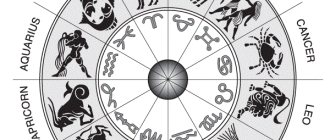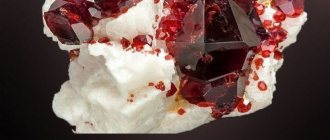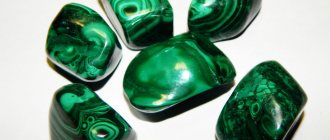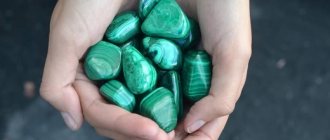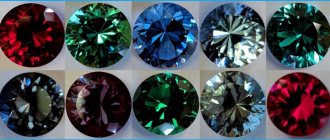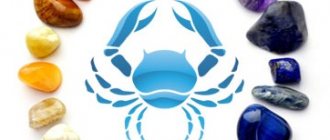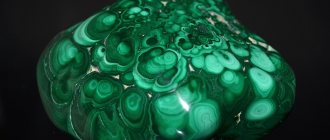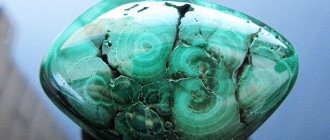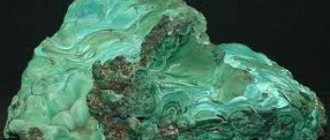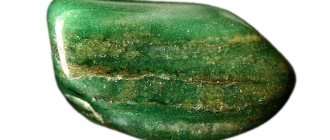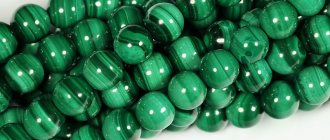DESCRIPTION AND PROPERTIES OF MALACHITE STONE WITH PHOTO
Malachite is a stone whose properties classify it as a carbonate. It is a valuable ornamental material. The formation of crystals occurs in the form of thin needles that never grow singly. They grow from the center, creating radiant balls - peculiar spherulites. Such spherulites creep on top of each other, forming kidney-shaped and grape-shaped intergrowths. These formations are fed by copper solutions containing varying amounts of copper. That is why each layer has its own shade.
Look at the malachite pictured, the photo shows its shades well: from bluish-green to dark green (almost black) with pronounced patterns on the cut. The patterns are especially visible on cuts and chips after polishing. The pattern is a beautiful pattern of rings and interlacing strips of different thicknesses. Specimens with thin concentric rings are of high value. This variety is called “peacock eye” or “stone”. When processing a mineral, they try to highlight its decorative properties as clearly as possible, especially its banding.
Malachite is found in two types:
Plisovy is a dense green mineral with a wavy-banded structure and a characteristic silky sheen;
Turquoise is a bluish-green variety that is concentrically banded. Particularly popular is a turquoise gem with a subtle pattern, with the so-called peacock eye.
Malachite jewelry
A variety of jewelry is made from malachite. At all times, such accessories were worn by high-ranking officials, queens, and noble ladies. With the help of malachite jewelry one could emphasize one’s status, because such jewelry was not available to ordinary people - they were considered a sign of power, luxury and wealth.
Currently, malachite jewelry is a fashionable and stylish accessory that can be used to add a bold and bright touch to an image, add some “zest,” and emphasize individuality.
Jewelry looks very different, depending on what metal the stone is set in. However, both in gold and in silver the mineral looks very impressive.
Malachite earrings can be of different lengths, shapes, and designs. Due to its bright color, the gem is often used to create unusual earrings, with fantasy lines and sharp geometry. When choosing jewelry, you should focus on your skin tone and hair color. Fair-skinned ladies with light brown hair are more suitable for malachite in turquoise shades, but for red-haired and brunettes, rich green stones with a pronounced pattern will be the best option.
Malachite beads should be selected carefully so that the jewelry does not look pretentious or too flashy. Here you can also find different designs and sizes. Multi-layered beads look beautiful, especially if their color matches the chosen outfit, preferably a monochromatic one.
Rings with minerals look very harmonious in any situation, but they are unlikely to suit business style, especially if the company you work for has introduced a strict dress code. Nevertheless, there are many occasions in which a malachite ring will become an indispensable accessory and will highlight your individuality. It could be a date, a party, a friends wedding, a family dinner, or even just a walk. Jewelry of this kind looks great in the summer, combined with light, airy sundresses in bright colors.
A malachite bracelet can highlight your style, even if it is small in size. In addition, it is believed that the stone is endowed with special energetic properties, which manifest themselves in the form of healing and magical properties. Therefore, when purchasing any jewelry made from minerals, do not forget that it is not only a beautiful accessory, but also your protector and assistant.
What shades of clothing goes with malachite stone?
Malachite is not quite a traditional color, so when choosing an outfit you should carefully select clothes to match it. Classic - white. However, the following combinations look no less expressive and stylish:
- light purple and dark purple;
- blue and yellow;
- sand and aquamarine;
- blue-black and pink;
- herbal and milk;
- bright purple and scarlet;
- pale pink.
When combining malachite with clothes of different shades, you can experiment and create your own bright and unforgettable images. The main thing is to look at yourself in the mirror before going out and evaluate the harmony of your appearance. If nothing bothers you, feel free to go out!
MALACHITE STONE IN THE PHOTO
Initially, the mineral was used as copper ore, because it consists largely of copper carbonate.
Natural, untreated malachite is characterized by a low shine, but when broken after polishing, a velvety quality is noticeable, which is why the gem is nicknamed “velvet ore.”
Possessing low strength and density, the mineral can be destroyed by high temperature and hot water. It is also unstable to ammonia and acids.
When heated, the stone begins to darken, and upon contact with acid, it dissolves, releasing carbon dioxide. It is also necessary to avoid mechanical impact - malachite is easily scratched.
Look at the malachite stone in the photo; it owes its amazing beauty to the presence of copper and geological processes. The growth of crystals depends on the amount of free space. And the width of the alternating light and dark layers in the mineral depends on the amount of copper in the copper sulfate solution, which is the basis of the formation. The optical properties of the gem also depend on these indicators.
The color of malachite resembles turquoise and is one of the most beautiful shades of green.
However, the color scheme within one sample varies in depth and color saturation, creating an amazingly beautiful striped pattern, unique for each sample.
WHAT DOES MALACHITE LOOK LIKE
Anyone who has seen what malachite looks like will agree that it is one of the most beautiful stones. All kinds of shades from light bluish-green to rich dark green are present in this stone.
The unique texture gives the gem its unique character.
Depending on the angle of incidence of the light beam, some areas of the mineral appear lighter than others, the so-called pleochroism. According to the classifications of the mineralogist from Germany M. Bauer and academician A.E. Fersman, malachite occupies a leading position among semi-precious stones, along with lapis lazuli, rock crystal, agate and jasper.
MALACHITE PRODUCTS
Anyone who read Bazhov’s fairy tales about the mistress of the Copper Mountain in childhood knows about the malachite box. But not only the malachite box is made from this beautiful gem.
Bowls, vases, cladding plates for interiors and furniture inlays are cut from it.
Jewelry craftsmen use the most beautiful gems in the form of cabochons for inserts into jewelry.
Large malachite products are made using the mosaic technique. This method of Russian mosaic was used when facing columns in St. Isaac's Cathedral. To do this, the mineral was sawn into plates, which were later cut out and adjusted to match the design. Thus, the plates merge into one pattern. It is very difficult to believe that this is not a whole piece of stone, but a mosaic put together by the skillful hands of masters.
In Russia, malachite has been known since the 17th century, but the mass use of the stone began only in the 18th century, when huge malachite monoliths were found at the Gumeshevsky mine. Since then, the mineral began to decorate expensive palace interiors. From the middle of the 19th century. Tens of tons were brought from the Urals every year. In the State Hermitage, the famous Malachite Hall required 2 tons of malachite. There is also a large malachite vase. Products made from malachite can also be found in the Grand Kremlin Palace in the Catherine Hall. But the columns at the altar of St. Isaac's Cathedral are considered the most amazing in size and beauty; their height is 10 m.
The uninitiated think that columns and vases are monolithic products. In fact, these products are made of plaster, metal or other material. And on top they are lined with malachite tiles - a kind of malachite “plywood”.
| Physico-chemical properties of malachite | |
| Chemical formula: | Cu2(CO3)(OH)2 |
| Syngony: | monoclinic |
| Shine: | matte, silky |
| Color in daylight: | green |
| Coloring under artificial light: | doesn't change |
| Refraction value: | 1,656-1,909 |
| Hardness index: | 3,5-4 |
| Transparency level: | opaque |
| Density indicator: | 3,75-3,95 |
| Trait color: | green in different shades |
| Cleavage: | perfect |
| Kink: | splintered, shell-like |
Moreover, the larger the original piece of malachite was, the larger the tile was cut from it. And to save valuable natural material, the thickness of the tiles was sometimes 1 mm. But the main trick was to lay the tiles in tact, taking into account the pattern, so that each of them was a continuation of the previous one.
Other malachite products
Not only jewelry is made using malachite inserts. Various interior items made from minerals also look very original, for example, flowerpots, boxes, dishes, writing instruments, ashtrays, animal figurines, figurines.
Many people know that in Russia there are several famous halls in which the walls are lined with gemstones. This is a room in the Hermitage where everything is made of green mineral. It’s called the Malachite Hall. The second room is a hall in a St. Petersburg mansion on the street. B. Morskaya, 43. And third - the living room in the Winter Palace. And the largest interior works with malachite were performed in St. Isaac's Cathedral.
The mineral is also used to decorate fireplaces, swimming pools, build columns, picture frames and much more.
DEPOSITS OF MALACHITE IN THE URAL
Malachite is a valuable industrial ore. But its significance is very limited, since the malachite accumulation is concentrated in the upper, rapidly mined layer of the copper deposit. Sintered malachite with a beautiful pattern is a valuable ornamental stone, widely used in decorative and artistic products.
Today the mineral is supplied from Zaire, Africa, Kazakhstan, and Western Europe. The gem is less common in the form of a large mass. In Russia, the lead in mining is occupied by the Mednorudyansky mine, located near Nizhny Tagil, in second place is the Gumeshevsky mine, where a large malachite block was mined, the weight of which was 1.5 tons.
The block is in the Mining Institute. There are other Ural deposits. Malachite is also found in Kazakhstan and Altai. If previously the main mining of malachite was in the Urals, today it has ceased in this area, since these deposits have been depleted. And once upon a time these were very rich malachite accumulations.
By the way, Ural malachite was discovered back in 1635, and already in the 19th century. it was mined up to 80 tons per year. These were heavy blocks of high-quality natural mineral. The weight of the largest block was 250 tons, it was found in 1835, and in 1913 a block weighing more than 100 tons was discovered.
Dense malachite in solid masses was used for malachite jewelry (pendants, necklaces, earrings, rings, cufflinks), and individual grains of the mineral distributed in the rock (earthy malachite) and small accumulations of pure gem were used to make high-quality green paint, the so-called “malachite green.” " “Malachite green” should not be confused with “malachite green,” which is a simple organic dye and has something in common with the mineral, except perhaps its color.
In Yekaterinburg before the revolution one could see the bluish-green roofs of many mansions. They were painted with malachite, which attracted not only connoisseurs of all things beautiful, but also copper smelters. Copper was extracted exclusively from that stone, which was of no value to artists and jewelers. Whole pieces were used only for making jewelry.
In smaller quantities, but today malachite is also mined; mining is carried out in Western Europe: in Chessy, Retzbania, Cornwall, and the Harz. Today's main deposits of malachite of jewelry and finishing quality are located in the Democratic Republic of the Congo. African stone is characterized by regular concentric rings of small size with a more contrasting change of dark and light layers. Unlike this mineral, Ural gems have irregularly shaped rings.
Malachite stone products
With the onset of spring, all the colors of nature come to life, everything grows and blooms, drowning in waves of countless aromas and greenery. Probably the most favorite color of many of us in spring is green. This color has a balance of warmth and coolness. Green color lifts your spirits.
Despite the fact that there is a lot of green in nature, we often use it in clothing, interior design and decoration. Green tones evoke a positive attitude and calm. And, apparently, this is why, especially in spring, the green color evokes special feelings of beauty. For many, green is the color of eternal life. And it is this color that carries within itself the beautiful stone of “bright juicy, cheerful and at the same time silky-delicate greenery” - the malachite stone.
Malachite is one of the most beautiful minerals. Its palette is made up of green tones from light green to dark green (“plush”). It is believed that the stone received its name from the Greek word “??????” – mallow, a plant whose leaves are bright green. And the color of malachite is actually explained by the presence of copper ions.
The texture of malachite is varied - flowing, ribbon, circular concentric, radiant-stellar. The stone alternates layers of different colors.
In terms of its chemical composition, malachite is a copper carbonate salt - Cu2[CO3] [OH]2, where copper oxide contains the most - up to 72%. This is why malachite was originally used as copper ore.
Malachite is a fragile stone, when broken it has a silky sheen. It has attracted people's attention for a long time. They decorated buildings and halls, made tabletops, columns and amulets. The ancient Egyptians loved jewelry made from this beautiful stone, especially cameos.
However, the passion for malachite began after the discovery of a rich deposit in the Urals in the 18th century. But it was found in the foothills of the Urals back in 1635. Small stones were used to make beautiful decorations and magnificent paints, and large stones were used to make vases, bowls, tabletops and columns. Russian masters especially amazed the world with the perfection of their work and the depth of their artistic perception of malachite. And Russia’s malachite business gained worldwide recognition.
Russian craftsmen developed a method for making products from malachite, which was called “Russian mosaic”. Malachite was sawn into thin individual plates, from which a design was then selected and glued onto marble or metal. The entire product - the bowl or tabletop - looked as if it was made from one single piece of stone.
In the 18th – 19th centuries, malachite became a fashionable stone among the nobility; it was used to decorate mineral cabinets in Russia and Europe. Catherine II in the Winter Palace, natural scientists P.S. Pallas, I.I. Lepekhin, and Count N.P. Rumyantsev had rich collections of Ural malachite.
The Museum of the Mining Institute in St. Petersburg displays giant malachite stones - one weighing 1.5 tons from the Gumeshevsky mine (owner A.F. Turchaninov, who ended up in P.P. Bazhov’s fairy tale “The Malachite Box”), another block weighing slightly more 0.5 tons from the Kyshtym mine (owner L.I. Rastorguev).
Malachite became a symbol of wealth, and even a sign of social distinction. The imperial court and the highest nobility sought to acquire things made of malachite. And Napoleon dreamed of taking the malachite collection out of Russia.
The Hermitage has a malachite hall, where you can admire products made from beautiful stone. There are more than a hundred different objects here - huge vases, tables, bowls, columns. The magnificence of these products amazes the imagination and evokes delight and admiration for the work of Russian craftsmen. Ural malachite is superior in its beauty to malachite from other deposits, which are located in Zaire, Australia, Chile, Namibia, and the USA.
Malachite jewelry - beads, brooches, rings, pendants are in great demand and are valued on a par with semi-precious stones. The famous malachite deposits of the Urals - Gumishevskoye and Mednorudnyanskoye - have been almost completely worked out, although, as scientists suggest, there are still countless treasures to be found on the famous fairy-tale mountains of the Urals.
And the fact that Copper Mountain is certainly fabulous has been known for a long time, read the tales of P.P. Bazhova. The Mistress of the Copper Mountain herself is a beautiful green-eyed maiden - in a word, a sight for sore eyes, and the clothes she wears are such that “... you won’t find another in the world. Made of silk malachite dress. There is such a variety. It’s a stone, but it’s like silk to the eye, even if you stroke it with your hand.”
Maybe there will be some master Stepan or Danila who will meet the Mistress of the Copper Mountain, and then the malachite treasures will again appear in all their glory. And she, “...This mistress, a malachite girl, loves to play tricks on people.” Yes, they say: “For the bad, meeting her means grief, and for the good, there is little joy...”.
There was this Stepan - he mined a lot of malachite. And how did it all happen? He met the Malachite Mistress. She told him to fulfill three conditions. Stepan completed the first two - he showed his courage and devotion, but the third - he could not forget the beauty of the Mistress.
The Mistress rewarded him for his courage and devotion - where Stepan worked, that’s how malachite came - either in pebbles, or even in huge blocks. But he didn’t live long in the world, he kept walking around as if he didn’t belong, and kept thinking about the green-eyed beauty. And when Stepan passed away, “... in Gumeshki after that all the wealth disappeared... and the malachite left... from that time on Gumeshki began to decline...”.
“...Here she is, that means what a Mistress of the Copper Mountain she is!”
HOW TO DISCOVER NATURAL MALACHITE?
The great demand for jewelry with malachite inserts has led to the appearance on the market of a synthetic analogue - artificial, synthetic malachite. Under these conditions, the question arises of how to distinguish natural malachite. One of the main methods for synthesizing imitation is pressing natural malachite chips up to 5 mm in size. It is mandatory to add appropriate dyes and hardeners at high temperatures. And since high temperature partially destroys natural malachite, green and dirty brown lines appear in the synthetic analogue. In such samples there is no unevenness characteristic of natural material.
Synthetic stones are duller than natural ones. Therefore, before determining whether it is malachite or an imitation, you need to carefully look at the mineral and twist it.
Although the fakes of the mineral are very primitive. The difficulty in obtaining a high-quality synthetic mineral is that for this stone, unlike many others, the main criteria are not transparency and chemical purity, but the color palette and texture. The pattern on the polished malachite surface is unique.
The appearance of the mineral depends on the size, shape and relative orientation of the crystals from which
